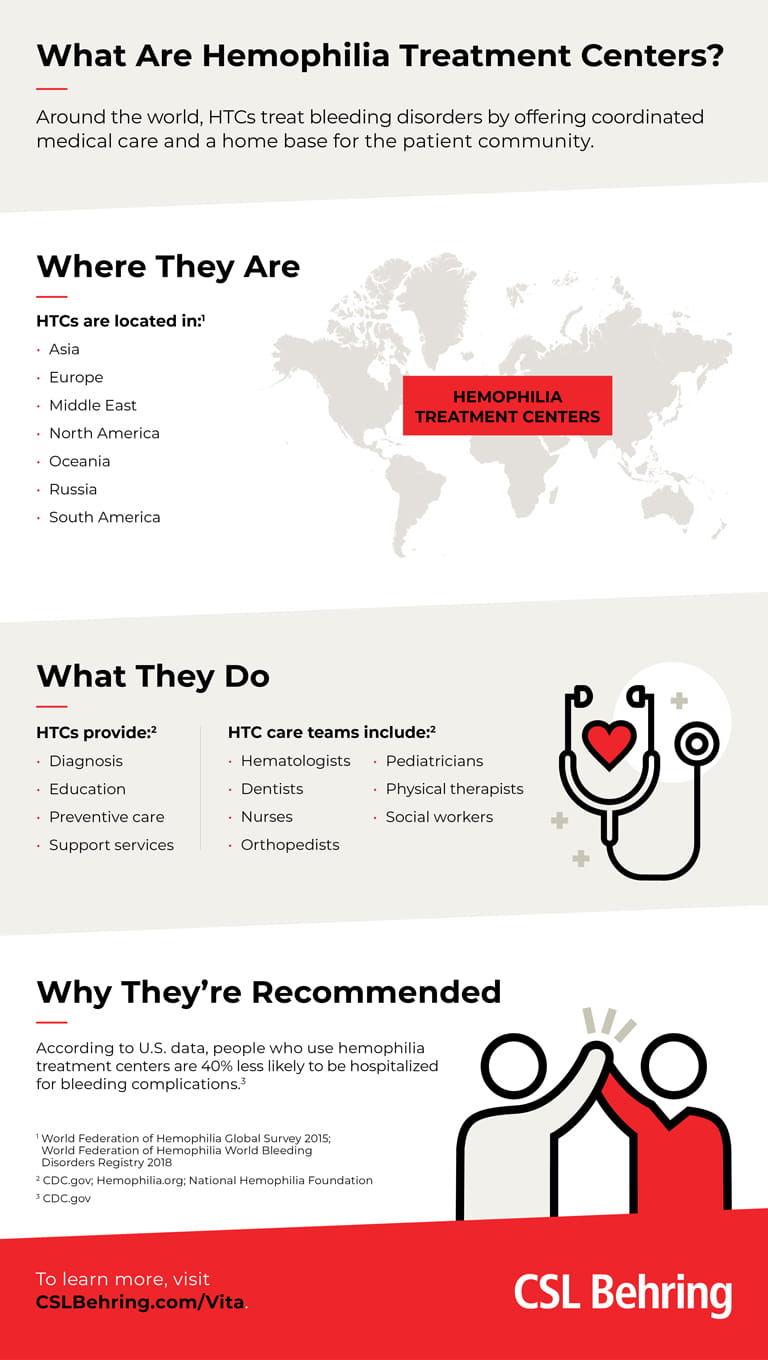
Do you know about HTCs? Hemophilia treatment centers (HTCs) in the United States – as well as a large network of global treatment centers – are beacons of hope and help by offering holistic, coordinated care for people who have a bleeding disorder.
People who have hemophilia, which means their blood does not clot as it should, are typically diagnosed when they’re very young. The disease, which varies in severity, requires a lifetime of care to prevent bleeding, joint damage and other problems. For someone who has hemophilia, an HTC can be a one-stop shop for their medical needs.
“People with hemophilia and other bleeding disorders come to hemophilia treatment centers to access comprehensive care and resources,” said Shirley Abraham, MD, director of the University of New Mexico Health System’s Ted R. Montoya Hemophilia Treatment Center. “Here, they can meet with a team of physicians, nurses, a physical therapist and a social worker; undergo blood draws to check for clotting factor levels, the presence of inhibitors and cell counts; and receive important education and support.”
The global network of hemophilia treatment centers includes 141 federally funded treatment centers and programs in the United States, as well as HTCs in Africa, the Middle East, Europe, Asia and Oceania. According to studies by the U.S. Centers for Disease Control, people with hemophilia are 40 percent less likely to be hospitalized for bleeding complications if they use hemophilia treatment centers. In fact, a yearly visit to a Hemophilia Treatment Center is No. 1 on a five-point list called “Do the 5!” created by the National Hemophilia Foundation along with the U.S. Centers for Disease Control.
Thanks to treatment advances, hemophilia has evolved into a manageable chronic condition. But both Hemophilia A and B remain complex diseases that require careful, consistent monitoring and healthcare. That’s where HTCs come in.
Centers for Evolving Care and Education
The youngest patients may need to visit a hemophilia treatment center every three to six months. As people age, a once-a-year visit is typically recommended, as well as if there are any concerns or bleeding episodes. A primary focus of the physicians, nurses and therapists at hemophilia treatment centers is to provide age-appropriate counsel and care.
“The conversation will be much different with parents of an infant coming in for the first time versus a 40- or 50-year-old patient,” said Dr. Abraham. “Early on we’ll talk about how to identify early bleeding symptoms, safe ways to receive vaccinations, how to injury-proof cribs and homes, creating a safe play area and the importance of medical bracelets, for example. As a child grows, we’ll educate parents on what to do as the child starts cruising and walking and eventually how they can safely participate in sports. We’ll also teach the child how to self-infuse [clotting] factor.”
In the pediatric population, the hemophilia treatment team aims to prevent injury and long-term joint damage, a common complication. As a patient grows, the importance of prophylactic treatment and always taking prescribed medications on time is continuously emphasized to prevent breakthrough bleeds. UNM’s hemophilia treatment center also offers programs like self-infusion bootcamps, family weekends and summer camps for pediatric patients.
As people age, they might need help meeting the health-related challenges of getting older, including additional chronic conditions. Again, HTCs can help with coordinated care and cooperation among medical providers.
“Because patients are living longer and staying more physically active, we’re also helping them manage common late-in-life procedures like joint replacements,” said Dr. Abraham. “It’s a newer aspect to hemophilia and bleeding disorder care.”
A Home Base for Care and Connection
HTCs naturally serve as an important source of data collection to learn more about the disease. The centers also help patients learn about the latest treatments, like gene therapy. Many patients and their families have been inquiring about their potential eligibility for such treatments.
“Hemophilia treatment centers will lead the way any time a potential treatment or therapy is gradually brought to the forefront,” explains Dr. Abraham. “Big studies requiring the collaboration of multiple centers will be required before something becomes the standard of care. “
The mission of an HTC is to help people manage their hemophilia so that they can achieve and maintain their best possible quality of life. This means both supporting both patients and caregivers and connecting them with one another, said Dr. Abraham.
“I really encourage people to visit a hemophilia treatment center,” she added. “There are many resources available there they may not find otherwise, and they can build a community and a support system.”


